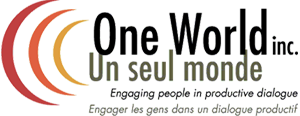Creating a Productive Dialogue Session by Ensuring Everyone Can Engage
 Ensuring productive dialogue involves giving everyone in the room the same opportunity to understand and engage appropriately. Part of that process involves being aware and knowing how to address any challenges while making accommodations for participants who are physically, visually or hearing impaired.
Ensuring productive dialogue involves giving everyone in the room the same opportunity to understand and engage appropriately. Part of that process involves being aware and knowing how to address any challenges while making accommodations for participants who are physically, visually or hearing impaired.
The HRSDC Conference
In March of 2010, Canada ratified the UN Convention on the Rights of People with Disabilities at United Nations headquarters in New York City. The Human Resources and Skills Development Canada (HRSDC) Rights of Persons with Disabilities Cross Governmental Conference was designed as a first large-scale forum for intergovernmental discussion of implications for application of the Convention within the public service sector. Organizers of the event wanted to create an opportunity for participants to have productive dialogue about what this means in terms of best practices and what the government will need to do to more effectively integrate people with disabilities into the workforce. With representatives from over 30 Canadian government ministries and departments, along with invited representatives from various disabilities communities in the room, the goal of the conference was also to model good practice ensuring that all those attending could participate actively in the rich discussions that would take place. One World Inc. was delighted to engage with the organizers to assist in the design and to facilitate this important event.
Facilitating Simultaneous Engagement
In the dialogue, we had multiple levels of simultaneous translation and interpretation working together using different methodologies as a large number of both presenters and participants were physically, vision or hearing impaired. All were available also in both official languages. To promote cross conversation, we employed some interesting facilitation techniques. For example, to enable small group discussion, we had professional interpreters sitting with people at the tables. For the visually impaired, we provided interpretation for everything that was written or posted and we had signed interpretation for those who were hearing impaired. To ensure all people- regardless of limitation- were able to participate actively, we relied heavily on technology to create the necessary dynamics. Several different kinds of overhead screens, earphones, and other computer-based technologies made active engagement not only possible, but highly successful. Close attention was also paid to using an accessible venue, room layout and proper accommodation of the friendly and helpful guide dogs who also participated in the day.
The Outcome
The conference was a fantastic learning environment and a spectacular display of how people who were visually impaired could hear what was being presented with an earpiece, while others with a hearing impairment could see the hand translation and engage in conversation easily. It sensitized everyone in the room, giving all of us the opportunity to experience firsthand the rewards of working through challenges to get past impairment and support people to be as productive as possible in the work environment.
The takeaway from the HRSDC conference was positive, highlighting the importance of working to create the right dynamics for all people, despite physical, vision or hearing challenges to engage in productive dialogue. With the right opportunity and access to a variety of innovative technology, everyone who chooses to participate in a dialogue session can be equally represented, informed and engaged.
